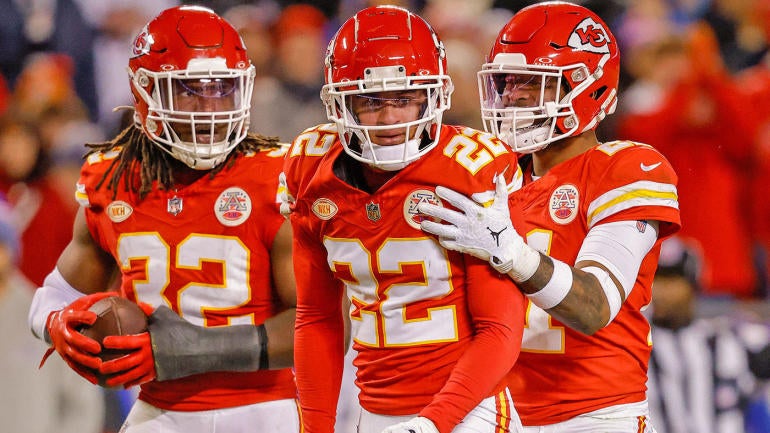
The Kansas City Chiefs, back in the Super Bowl for the second straight year, will be donning red jerseys for Super Bowl LVIII next week because they won in them four years ago against this same opponent, and because the color will give them a slight advantage thanks to tens of thousands of years of human behavior.
There's a clash -- quite literally -- of reds in Las Vegas as the Chiefs take on the 49ers. When they met in Super Bowl LIV in 2020, I wrote a couple thousand words for this website about the meaning of these colors in this game. At that point, it was the first Super Bowl with two teams who both wore red. And as the designated home team, Kansas City got to choose its jersey color and stuck with the red tops that got them through the playoffs, as well as their lone Super Bowl win in 1970.
Yet again, the Chiefs are the designated home team. And instead of going with the white tops that won them road games in Buffalo and Baltimore the previous two weeks -- as well as the Super Bowl last year against the green-clad Eagles -- the Chiefs went with the dominant red color. That puts the 49ers back in white tops, which they've wore in three previous Super Bowls.
San Francisco's only Super Bowl loss in white? Super Bowl LIV to the Chiefs. While the color red hasn't changed, some other things have since I last wrote this piece, which is now becoming a quadrennial affair. You can read the full story from four years ago here, but I'm also going to pull passages from the piece throughout this story (which will be italicized).
Here's what red means to both a color expert and a biologist.
For all of recorded human history, color expert Leatrice Eiseman says, red has represented activity, assertiveness, blood and bloodshed. Red is aggressive, dynamic and an activity producer.
"There's never anything reticent or quiet about red," Eiseman told me by phone while in France on a tour for "More Alive with Color," her latest book. "And in recent years there's another buzzword that's been used. It isn't just power but empowerment. So that if you adorn yourself in red, if you use red, psychologically that can give you the feeling that you are more powerful."
Anger and aggression are associated with reddening of the skin, while fear produces a paling effect as blood drains from one's face. While we understand red can also be symbolic of love, romance and fertility, in the animal kingdom red usually correlates with male dominance.
Russell Hill is a professor of evolutionary anthropology at Durham University in the United Kingdom. A trained biologist, Hill has long been interested in what primate behavior can tell us about human evolution and human socialization.
Take, for example, the mandrill. That's the primate with the beautiful red and blue-colored face that you've seen on wildlife television or, better yet, the type of primate Rafiki was in "The Lion King." For millennia, life on this planet has immediately and readily understood what the color red signifies.
"That bright, intense red coloration is actually present only in dominant male," Hill said. "If you're not a dominant male that red color just washes out. It's a badge of status. If you look across a lot of other mammal species, red is the color. It's used to signify dominance and aggression in a wide variety of animals."
Red may mean something to mandrils, but it didn't mean anything to the GOAT. A year after the Chiefs beat the 49ers, 31-20, in Super Bowl LIV, Kansas City donned red again in Super Bowl LV and lost, 31-9, to the white-jersey'd Tampa Bay Buccaneers.
The red that Kansas City's backup tackles cloaked themselves in couldn't help them enough in that game. But there is evidence that wearing red in sporting events has an impact on the mind, even if that doesn't exactly play out with the body.
We know humans perceive those in red as more aggressive and dominant. And there are self-reported studies of people feeling more confident when wearing red.
"What we know from those primate examples linked to that red coloration is higher levels of testosterone that is often involved in these competitive encounters," Hill said. "And we know that male sports teams playing at home go onto the field with higher levels of testosterone than when they're playing away from home. It primes the body for competition.
"The evidence is less clear -- in fact there's no clear evidence -- that wearing red influences your physiological preparedness in that way. It clearly has a psychological impact, but it's much more difficult to test these physiological responses. As it stands at the moment, nobody's been able to find evidence that I would be confident in claiming is irrefutable."
Just like in the 2019 season, the Niners ran through the NFC playoffs in their red jerseys just to end up in white. But actually, both of these teams this year have been more successful in their white tops.
San Francisco is 5-1 in white jerseys this year and 9-4 in its reds. Kansas City went 7-4 in its red jerseys and 7-2 in the whites.
If you ask me, Super Bowl LIV between these two teams was not aesthetically pleasing. Both teams have the same colors, except they don't. The 49ers are in gold pants, and the Chiefs have that yellow in their color scheme. The Chiefs have a more vibrant red than the darker red the 49ers wear.
The official color system is known as the Pantone Matching System. The Chiefs' red is PMS 186 C, with the 49ers' red as PMS 187 C. So they are officially one pantone apart. Eiseman, the color expert, told me the deeper tone in the 49ers' red adds more depth, more focus and more intention.
"Now, not to say that the other team doesn't have focus. I don't want to put that on them," Eiseman told me in 2020. "But if we're looking at from the standpoint just of the messaging of the color, I think that's the biggest distinction between the two of them. One is a little more adrenaline pumping and the other is a little bit more thoughtful, if you will."
How's this going to look on television? I would expect the end zones to be painted the same as their Super Bowl LIV meeting. The Chiefs end zone was yellow with red lettering, and the 49ers had a red end zone with gold lettering. In the two Super Bowls the Chiefs have played in since then, they've had yellow end zones.
Trust me, the CBS broadcast is aware of the colors. In the CBS broadcast of Super Bowl LV, the Chiefs and Buccaneers actually had the same color red (PMS 186 C). In the score bug, CBS went with the Chiefs in red and the Buccaneers in pewter, which was the color of Tampa Bay's pants. Next week, the score bug on CBS will have the Chiefs in red and the 49ers in gold.
But does any of this really matter? Are the Chiefs actually going to win simply because they're in red? Sure, Kansas City won wearing red against the Niners four years ago, but then it got spanked a year later by the Bucs in white.
Twelve previous Super Bowls have featured at least one team with red as their dominant color. The teams in red have gone 6-6 in those games.
Hill told me the team in red jerseys may have one small, slight advantage over the team in white. Just maybe.
"The way we would probably expect it to operate anyway is not the buildup to the game but on the field itself ... athletes on the line of scrimmage, in opposition of another. They very much are facing one another as the ball is snapped," Hill said. "I think in those particular contexts where it could have an impact on the San Francisco players, those athletes all looking at athletes dressed in red, each of whom is displaying this color that has this evolutionary association with power and dominance.
"It's in that particular context and in those very fine margins that we expect it to have a difference. If it just takes one or two percent off the degree that these players go into impact, the energy that they put into it, and these games are fine margins, that can be enough to tip the balance between winning and losing."






















